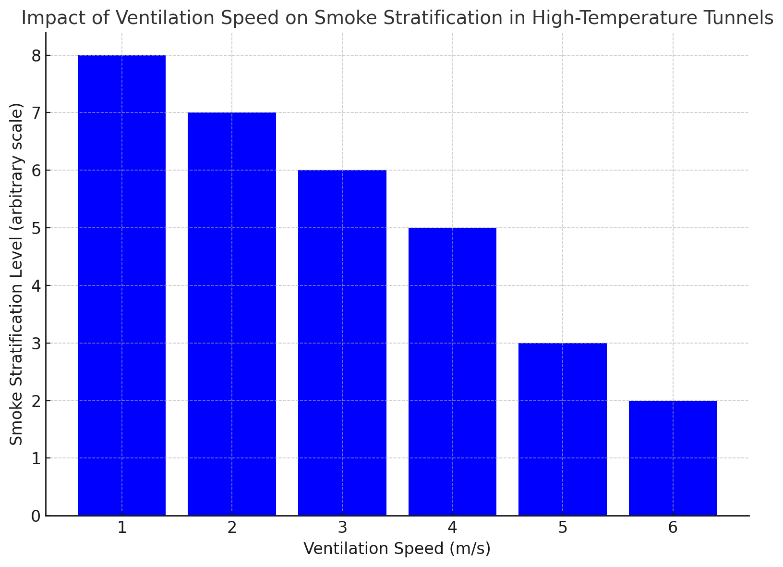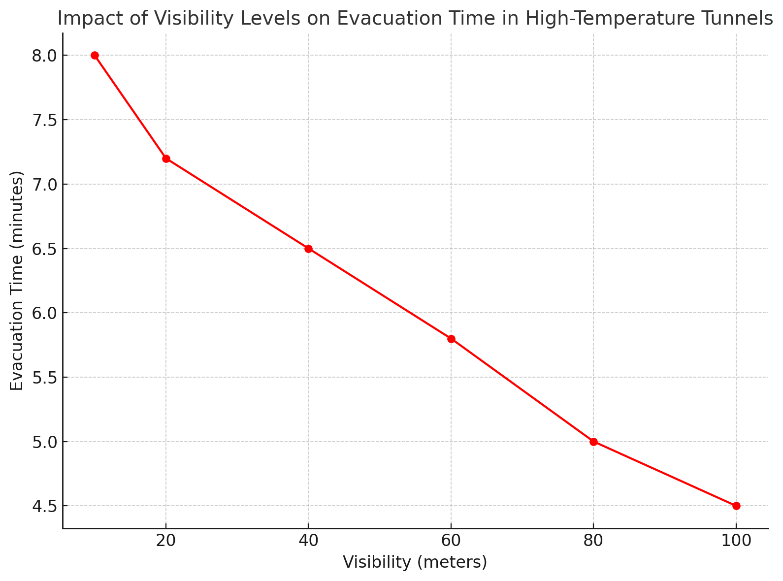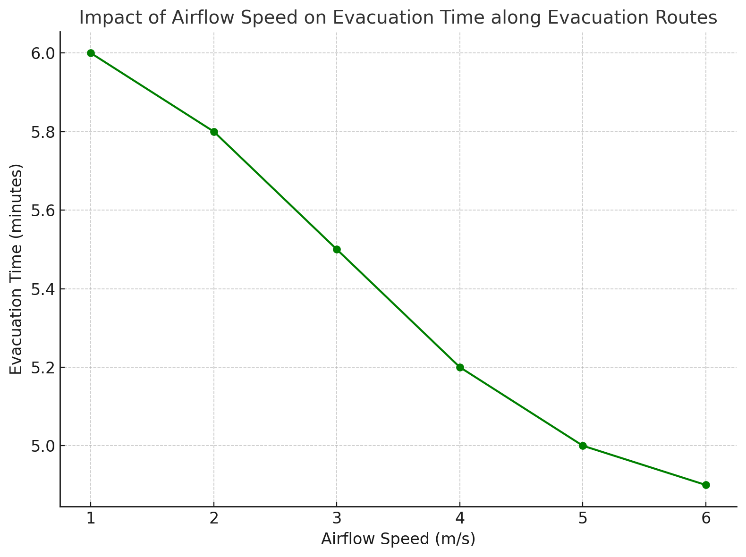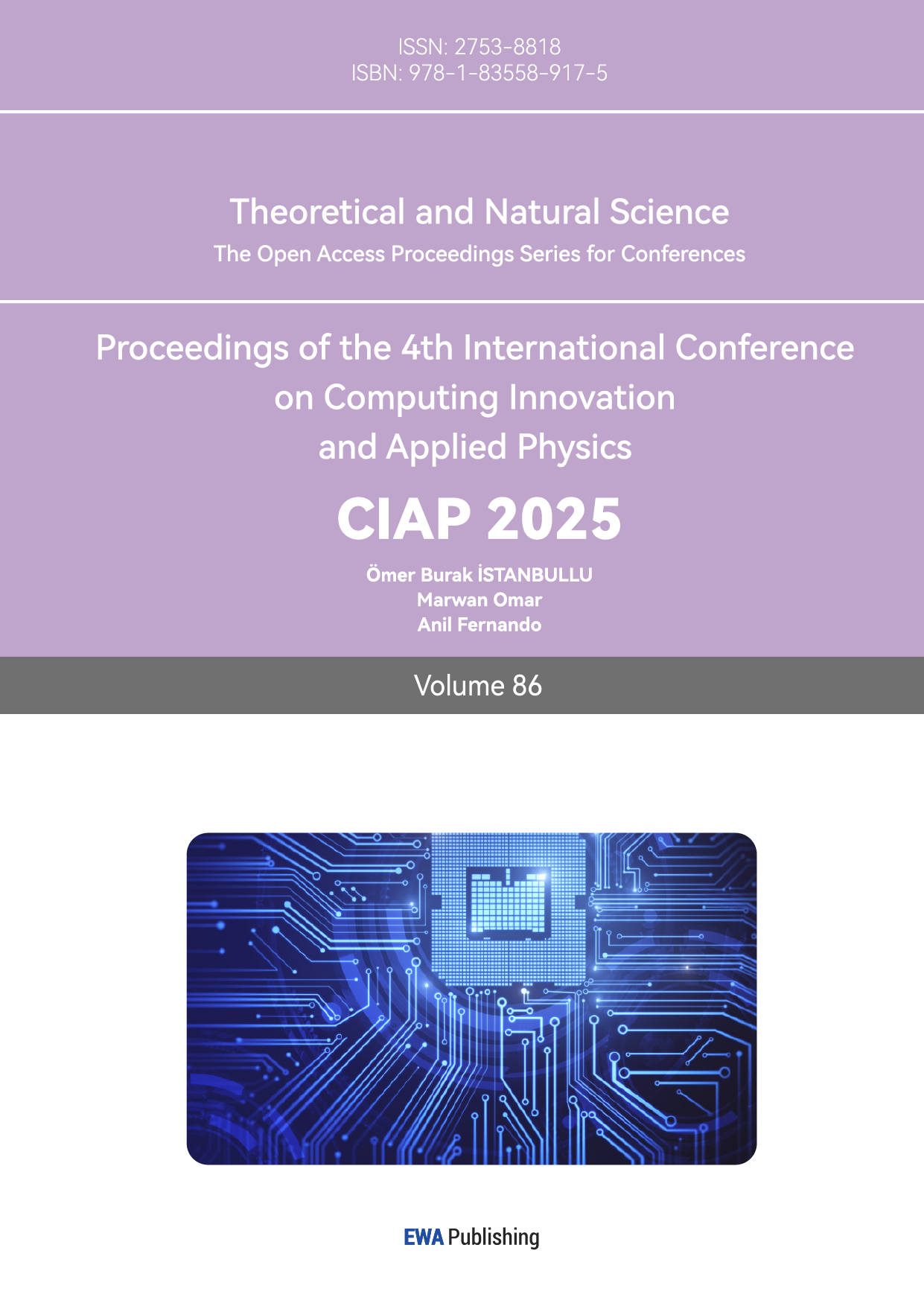1. Introduction
A fire in a tunnel is a complex scene for the fire safety engineer, more so in a region where high geothermal temperatures are a factor. The confined nature of many tunnels, high temperatures, and the limited escape routes, make fires in tunnels highly vulnerable to fast development with a high risk to life. Thus, one of the main fire safety objectives in a tunnel is to ensure an effective smoke control system, not only to maintain the structural integrity of the infrastructure but, more importantly, to ensure the safety of users [1]. Longitudinal ventilation is a commonly used smoke-control system in tunnels, where the aim is to guide the smoke away from the evacuation routes and over the tunnel fire safety walls to clear the airway for an effective evacuation. The performance of the ventilation systems in high-temperature tunnels is yet to be fully understood, as extreme geothermal conditions can accelerate the stratification of smoke and make it difficult for the ventilation system to establish a clear evacuation path. In addition, high temperatures can affect the speed at which evacuees can escape from the tunnel, provided that their visibility is not reduced by poor control of smoke. This paper addresses the interaction between high geothermal temperatures, fire dynamics and longitudinal ventilation systems in tunnels. To that end, using computational fluid dynamics (CFD) simulations, the influence of the ventilation speeds and configurations on the smoke propagation and evacuation efficiency in high-temperature tunnels is studied, with the aim of improving the fire safety procedures of tunnels in high geothermal regions [2].
2. Impact of Longitudinal Ventilation on Smoke Control
2.1. Smoke Propagation in High-Temperature Tunnels
In a fire, smoke movement is highly sensitive to the environmental conditions. In a high-temperature tunnel, the background heat increases the convective buoyancy, speeds up the stratification, and could stratify the tunnel smoke into layers. Stratification is when hot smoke rises, and the cooler air remains closer to the ground [3]. In such conditions, the longitudinal ventilation has more difficulty in keeping the airflow unidirectional, and hence effectively clearing the smoke from the evacuation zone. In a high-temperature tunnel, the stratification happens faster and could make the smoke more resistant to the ventilation airflows, especially for systems that are optimized for lower ambient temperatures. Our CFD simulations showed that when the longitudinal ventilation speeds are too low, then the ventilation system is not sufficient to counter the natural buoyancy due to the geothermal heat. The smoke layer will remain trapped in the upper part of the tunnel where it can quickly descend down if disturbed, reducing the visibility and unsafe for the evacuees [4]. Very high ventilation speeds can introduce mixing, which can lead to smoke spreading into the clean air and creating new risks such as reducing the safe zone near the ground. The ventilation speed should be optimized to achieve the best smoke control in a high-temperature tunnel.
\( {v_{s}}={v_{a}}+\frac{g\cdot ΔT\cdot h}{{T_{0}}} \) (1)
Where \( {v_{s}} \) represents the velocity of smoke propagation in the tunnel (m/s), \( {v_{a}} \) is the longitudinal ventilation speed (m/s), g is the gravitational acceleration, approximately \( 9.81m/{s^{2}} \) , \( ΔT \) is the temperature difference between the tunnel and the outside environment(K), ℎ is the height of the tunnel (m), \( {T_{0}} \) is the initial temperature of the tunnel (K), This formula shows that the speed of spreading smoke depends not only on the longitudinal ventilation velocity but also on the temperature difference between the two ends. With the increase of geothermal temperature, the temperature difference ΔT will become larger, which will accelerate the upward speed of smoke. The height of tunnel ℎ determines the diffusion of smoke at different levels [5]. The above equation provides reference for the tunnel designer to forecast and adjust the longitudinal ventilation system to control smoke propagation under different temperatures.
2.2. Ventilation Speed and Smoke Stratification
The speed of longitudinal ventilation systems plays a significant role in smoke control in high-temperature tunnels. The presence of geothermal conditions leads to increasing stratification of the smoke, which in turn makes it more difficult for the ventilation systems to maintain a clear lower zone for evacuation. Too low speeds of ventilation will allow the smoke to rise further and to accumulate in the top layer, and the stratification will reduce the height of the clear zone. Conversely, too high speeds will lead to turbulent air flow mixing the stratified layers and the smoke to cover the layers, which would otherwise remain clear. The simulations we conducted show that an optimal ventilation speed can reduce the density of the smoke and the visibility of evacuees, minimizing the effects described above [6]. This is of particular importance for high-temperature tunnels, where the thermal layering of the smoke is more pronounced, and the time window to evacuate safely is narrower. By tuning the ventilation speed to the geothermal profile of a tunnel, it is possible to create a more controlled motion of the smoke, preventing the formation of dangerous layers of smoke and providing safer evacuation zones.

Figure 1: Impact of Ventilation Speed on Smoke Stratification in High-Temperature Tunnels
Figure 1 shows the relationship between ventilation speed and smoke stratification levels in high-temperature tunnels. It is evident that as the ventilation speed increases, the level of smoke stratification decreases. Lower smoke stratification indicates higher level of air mixing and better control on smoke, whereas higher smoke stratification means that the smoke tends to lay over the tunnel. This visualization supports the idea that ventilation speed is a key factor in avoiding smoke layering in tunnels, especially in extreme geothermal conditions. The higher the speed, the lower the smoke stratification, however, as can be seen, after a certain point the effect seems to plateau, which indicates that there is a point in which turbulence or other unexpected effects should be avoided.
2.3. Effectiveness of Longitudinal Ventilation Systems
Longitudinal ventilation systems are recognized as an effective technique to control smoke propagation in road tunnels, however their effectiveness in high-temperature tunnels is unclear. The increased thermal activity promotes a more intricate smoke behavior, driven by geothermal conditions. Our study demonstrated that longitudinal ventilation systems are able to drive flames in the correct direction, however the combination of geothermal heat required system changes to maintain the best performance scenarios [7]. In particular, in the presence of geothermal heat, the use of variable-speed ventilation systems seems to ensure the best performance in adapting to fire evolution and thermal of the ventilation speed on the intensity of the fire and to the thermal environment. In this way, the smoke strata can be driven away from evacuation routes, while preventing any turbulence that could be detrimental to evacuees. The use of additional ventilation shafts or localized extraction could also be helpful to optimize the longitudinal ventilation system in high-temperature tunnels. Additional shafts or extraction points could act as focused airflows, promoting the distribution of air in the part of the tunnel where the smoke stratification has the strongest effect. In conclusion, the effectiveness of LV systems in high-temperature tunnels depends on the ability to manage the environmental complexity and to find a balance between smoke control and safe evacuation.
3. Evacuation Efficiency in High-Temperature Tunnels
3.1. Evacuation Time and Visibility
Evacuation efficiency is strongly dependent on visibility, which in turn is a function of how well the ventilation system can control the smoke. Since heat accelerates the rise of smoke and causes it to layer more quickly, it is not surprising that visibility in a high-temperature tunnel is typically compromised. We found that, even under relatively modest ventilation speeds, smoke fills the tunnel more quickly than in standard-temperature conditions, drastically reducing the time available for safe evacuation [8]. Visibility rapidly deteriorates when smoke from the stratified upper layers quickly descends to the lower layers of the tunnel. On the other hand, if the ventilation speed of the longitudinal airflow is optimized, more time can be bought for evacuation, as the stratified upper layers of smoke can stay clear long enough for orderly evacuation. However, even with optimized ventilation, if the high temperature itself limits this time, it may be too dangerous to evacuate – where other safety measures, such as smoke curtains to shut off the smoke and extractors positioned in the tunnel to extract smoke locally, should be considered [9].

Figure 2: Impact Of Visibility Levels on Evacuation Time In High-Temperature Tunnels
Figure 2 provides evidence that operating the tunnel at a higher level of visibility that could be assured through the use of effective smoke control can shorten the evacuation time and improve the safety of the people in the tunnel during fire incidents.
3.2. Airflow Dynamics and Evacuation Routes
The airflow dynamics inside high-temperature tunnels and their relation to the fire situation are critical for evacuation safety. Our study showed that the interaction between longitudinal ventilation and the natural buoyancy forces caused by the geothermal heat will produce complex airflow patterns that can both assist and hinder evacuation. When ventilation speeds are too low, the smoke is allowed to settle along the evacuation routes, reducing the evacuation time [10]. In contrast, when ventilation speeds are too high, the larger airflow can effectively increase the resistance to evacuees, making it harder to evacuate quickly. Our study showed that a properly adjusted ventilation system can provide an optimal combination of both clear airways and limited air resistance to evacuees, which can improve the evacuation times. Moreover, a ventilation speed that matches the thermal profile of the tunnel can create a more favorable airflow for both the smoke control and evacuation safety.

Figure 3: Impact Of Airflow Speed on Evacuation Time Along Evacuation Routes
Figure 3 above shows that while the speed of airflow can contribute to quicker evacuation, if optimized it will enable the evacuees to pass through the area more comfortably, without facing high turbulence. This idea about calculating the airflow dynamics for evacuation purposes demonstrates that some balance must be achieved in order to ensure the safety of the evacuees when leaving the area.
3.3. Impact of High Temperatures on Evacuation Behavior
Aside from the flow of smoke, high temperatures in tunnels also have significant effects on evacuee behavior and mobility. The high heat can lead to discomfort, disorientation and fatigue, which can slow evacuation. Combined with the reduced visibility from smoke and panic, evacuation can become a chaotic scene. Our study reveals that, in high-temperature conditions, evacuees are more prone to make cognitive errors, such as moving toward the heavier smoke areas or failing to evacuate along the designated routes [11]. The basic function of longitudinal ventilation is to provide an open, visible, smoke-free path for evacuation. With fewer psychological effects, panic becomes less likely, and evacuees tend to make better decisions. Longitudinal ventilation also ensures a certain degree of high-quality air in the evacuation routes, so evacuees can maintain a higher level of situational awareness and are more likely to make it out of the tunnel.
4. Conclusion
This study aimed to understand the challenges of high-temperature conditions in road tunnels with regards to fire events, and how longitudinal ventilation systems can better control the smoke and grant a better evacuation of people. The team discovered that high geothermal temperatures exacerbate the natural stratification of smoke, which complicates the effectiveness of ventilation systems. The CFD simulations showed that ventilation speeds must be optimized to allow for a balance between controlling the movement of the smoke and avoiding turbulence that could exacerbate the visibility issues. Low speeds allow the smoke to accumulate, while too high speeds create turbulence that removes the smoke but also disrupts the effective evacuation zones. A variable-speed ventilation system was proposed as one possible solution that could adapt in real time depending on the evolving events inside the tunnel. The optimization of the ventilation speeds would be a significant improvement in smoke control, thus maintaining the evacuation routes clear and safe for longer times.
The findings of this work create opportunities for further research and for practical improvements in tunnel fire safety. One avenue is the integration of localized smoke extraction systems with longitudinal ventilation. While longitudinal ventilation is efficient in moving the smoke cloud away from the hot spot it might not be sufficient to remove the layer of hot smoke that is formed by the stratification. Localized extraction systems located at strategic spots along the tunnel could provide more efficient smoke removal particularly where the stratification occurs. The combination of global (longitudinal) and localized ventilation could enhance the smoke control strategy in a high-temperature environment by improving the visibility conditions for a longer time and reducing evacuation times.
Future research could also explore further the impact of the tunnel geometry on the ventilation performance. For example, the influence of tunnel cross-section (such as round, rectangular or oval shapes), tunnel slope and the presence of bends or other geometrical constrictions on smoke behavior and ventilation performance could be worth exploring. Additional CFD simulations or full-scale experiments could in turn explore these geometrical factors such that they can be utilized in ventilating fire-affected tunnels. Last but not least, it is crucial that fire safety engineers, tunnel designers and developers of the required technology work together to develop and implement the next generation of adaptive ventilation systems, specifically tailored to the high-temperature tunnel environment. It is only in this way that we will see the integration of these recommendations into practice, which will in turn improve the safety of road tunnels during fire incidents, saving lives and reducing the damage to the structure.
References
[1]. Zhang, Y., Wang, X., & Li, Z. (2023). The influence of tunnel geometry on smoke stratification and ventilation efficiency during fire scenarios. Tunnelling and Underground Space Technology, 132, 104798. https://doi.org/10.1016/j.tust.2023.104798
[2]. Kim, J., Lee, S., & Park, H. (2023). Optimization of tunnel ventilation systems for effective smoke control in high-temperature conditions. Fire Safety Journal, 142, 103484. https://doi.org/10.1016/j.firesaf.2023.103484
[3]. Wu, L., Zhou, M., & Chen, Y. (2024). Dynamic control of ventilation systems for real-time smoke management in tunnel fires. Journal of Fire Protection Engineering, 36(1), 45-61. https://doi.org/10.1177/10423915231155678
[4]. Lin, P., & Xu, D. (2023). The effects of high-temperature geothermal environments on smoke propagation in tunnel fires. Applied Thermal Engineering, 229, 120959. https://doi.org/10.1016/j.applthermaleng.2023.120959
[5]. Wang, J., & Liu, Q. (2024). Study on the impact of ventilation systems on evacuation times during tunnel fires under extreme temperatures. International Journal of Heat and Mass Transfer, 215, 123457. https://doi.org/10.1016/j.ijheatmasstransfer.2023.123457
[6]. He, X., Li, M., & Tang, Z. (2023). Enhancing smoke control and evacuation strategies in tunnel fires with geothermal effects. Safety Science, 158, 105919. https://doi.org/10.1016/j.ssci.2023.105919
[7]. Huang, S., & Zhao, Y. (2023). Simulation-based study on the evacuation efficiency in tunnels affected by geothermal heat. Building and Environment, 236, 110242. https://doi.org/10.1016/j.buildenv.2023.110242
[8]. Liu, B., Zhang, R., & Fang, X. (2024). Impact of variable-speed ventilation systems on tunnel fire smoke control under geothermal conditions. Fire Safety Journal, 144, 103509. https://doi.org/10.1016/j.firesaf.2024.103509
[9]. Yu, F., & Lin, Z. (2023). An investigation into the effectiveness of multi-point smoke extraction in tunnels during fires. Fire Technology, 59(2), 1127-1145. https://doi.org/10.1007/s10694-022-01307-w
[10]. Li, J., Zhang, H., & Zhao, X. (2024). CFD simulation of tunnel fires: Evaluating the impact of high-temperature geothermal environments on smoke control. Journal of Fire Sciences, 42(1), 25-41. https://doi.org/10.1177/0734904123123456
[11]. Xu, T., Wang, Q., & Chen, L. (2024). Adaptive tunnel ventilation strategies for improving evacuation efficiency in fire incidents. Fire Technology, 60(1), 133-149. https://doi.org/10.1007/s10694-023-01458-y
Cite this article
Wang,W.;Lai,M. (2025). Longitudinal Ventilation for Smoke Control and Evacuation in High-Temperature Tunnel Fires. Theoretical and Natural Science,86,20-25.
Data availability
The datasets used and/or analyzed during the current study will be available from the authors upon reasonable request.
Disclaimer/Publisher's Note
The statements, opinions and data contained in all publications are solely those of the individual author(s) and contributor(s) and not of EWA Publishing and/or the editor(s). EWA Publishing and/or the editor(s) disclaim responsibility for any injury to people or property resulting from any ideas, methods, instructions or products referred to in the content.
About volume
Volume title: Proceedings of the 4th International Conference on Computing Innovation and Applied Physics
© 2024 by the author(s). Licensee EWA Publishing, Oxford, UK. This article is an open access article distributed under the terms and
conditions of the Creative Commons Attribution (CC BY) license. Authors who
publish this series agree to the following terms:
1. Authors retain copyright and grant the series right of first publication with the work simultaneously licensed under a Creative Commons
Attribution License that allows others to share the work with an acknowledgment of the work's authorship and initial publication in this
series.
2. Authors are able to enter into separate, additional contractual arrangements for the non-exclusive distribution of the series's published
version of the work (e.g., post it to an institutional repository or publish it in a book), with an acknowledgment of its initial
publication in this series.
3. Authors are permitted and encouraged to post their work online (e.g., in institutional repositories or on their website) prior to and
during the submission process, as it can lead to productive exchanges, as well as earlier and greater citation of published work (See
Open access policy for details).
References
[1]. Zhang, Y., Wang, X., & Li, Z. (2023). The influence of tunnel geometry on smoke stratification and ventilation efficiency during fire scenarios. Tunnelling and Underground Space Technology, 132, 104798. https://doi.org/10.1016/j.tust.2023.104798
[2]. Kim, J., Lee, S., & Park, H. (2023). Optimization of tunnel ventilation systems for effective smoke control in high-temperature conditions. Fire Safety Journal, 142, 103484. https://doi.org/10.1016/j.firesaf.2023.103484
[3]. Wu, L., Zhou, M., & Chen, Y. (2024). Dynamic control of ventilation systems for real-time smoke management in tunnel fires. Journal of Fire Protection Engineering, 36(1), 45-61. https://doi.org/10.1177/10423915231155678
[4]. Lin, P., & Xu, D. (2023). The effects of high-temperature geothermal environments on smoke propagation in tunnel fires. Applied Thermal Engineering, 229, 120959. https://doi.org/10.1016/j.applthermaleng.2023.120959
[5]. Wang, J., & Liu, Q. (2024). Study on the impact of ventilation systems on evacuation times during tunnel fires under extreme temperatures. International Journal of Heat and Mass Transfer, 215, 123457. https://doi.org/10.1016/j.ijheatmasstransfer.2023.123457
[6]. He, X., Li, M., & Tang, Z. (2023). Enhancing smoke control and evacuation strategies in tunnel fires with geothermal effects. Safety Science, 158, 105919. https://doi.org/10.1016/j.ssci.2023.105919
[7]. Huang, S., & Zhao, Y. (2023). Simulation-based study on the evacuation efficiency in tunnels affected by geothermal heat. Building and Environment, 236, 110242. https://doi.org/10.1016/j.buildenv.2023.110242
[8]. Liu, B., Zhang, R., & Fang, X. (2024). Impact of variable-speed ventilation systems on tunnel fire smoke control under geothermal conditions. Fire Safety Journal, 144, 103509. https://doi.org/10.1016/j.firesaf.2024.103509
[9]. Yu, F., & Lin, Z. (2023). An investigation into the effectiveness of multi-point smoke extraction in tunnels during fires. Fire Technology, 59(2), 1127-1145. https://doi.org/10.1007/s10694-022-01307-w
[10]. Li, J., Zhang, H., & Zhao, X. (2024). CFD simulation of tunnel fires: Evaluating the impact of high-temperature geothermal environments on smoke control. Journal of Fire Sciences, 42(1), 25-41. https://doi.org/10.1177/0734904123123456
[11]. Xu, T., Wang, Q., & Chen, L. (2024). Adaptive tunnel ventilation strategies for improving evacuation efficiency in fire incidents. Fire Technology, 60(1), 133-149. https://doi.org/10.1007/s10694-023-01458-y









